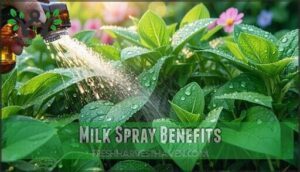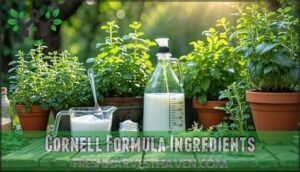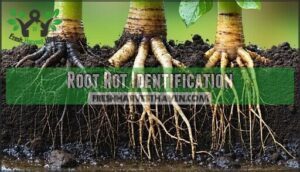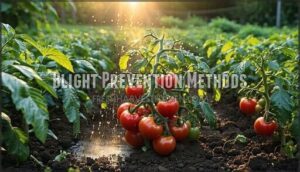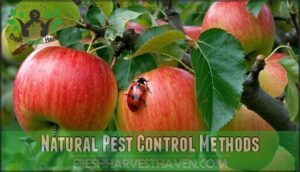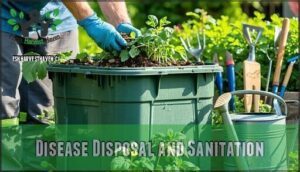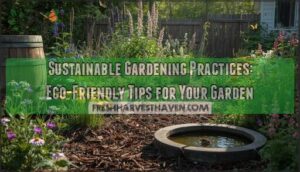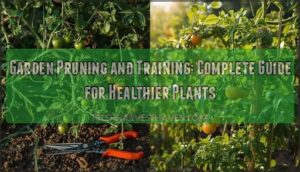This site is supported by our readers. We may earn a commission, at no cost to you, if you purchase through links.
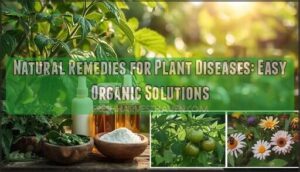
Milk spray acts as a natural fungicide, containing proteins that boost plant resistance. Baking soda mixed with water changes leaf surface pH, preventing fungal spores from establishing.
Neem oil disrupts disease cycles while remaining safe for beneficial insects. Sulfur dust creates an alkaline barrier that fungi can’t penetrate.
These solutions target root causes rather than just symptoms, making your garden more resilient long-term. The secret lies in understanding which remedy matches your specific plant disease challenge, to create a more hostile environment for pathogens and boost your plants’ overall health.
Table Of Contents
- Key Takeaways
- Natural Disease Prevention
- Organic Fungicide Options
- Common Plant Diseases
- Natural Pest Control Methods
- Disease Disposal and Sanitation
- Frequently Asked Questions (FAQs)
- How to cure plant diseases naturally?
- How to treat plant diseases organically?
- How to get rid of diseases in plants?
- What is the best natural antifungal for plants?
- What are early signs of plant nutrient deficiency?
- How can I revive a stressed plant naturally?
- What plants benefit most from homemade compost?
- How to protect indoor plants from fungal infections?
- What natural treatments are safe for edible plants?
- Can essential oils replace commercial plant fungicides?
- Conclusion
Key Takeaways
- You’ll strengthen your plants’ immune systems using milk spray, baking soda solutions, and neem oil that create hostile environments for harmful pathogens while remaining safe for beneficial insects.
- You can prevent most plant diseases by monitoring your plants weekly, adjusting watering schedules to early morning, ensuring proper drainage, and applying natural fungicides preventatively rather than reactively.
- You’ll find organic fungicides like Cornell Formula (baking soda, horticultural oil, mild soap, and water) work by creating alkaline conditions that fungi can’t tolerate when applied during cool, cloudy conditions.
- You must properly dispose of infected plant materials through deep burial, controlled burning, or high-temperature composting while sanitizing your gardening tools with alcohol or bleach to prevent spreading diseases throughout your garden, using proper drainage and sanitizing methods.
Natural Disease Prevention
You can prevent most plant diseases by watching your plants closely and catching problems early.
Simple adjustments to watering schedules, light exposure, and natural fungicide applications will keep your garden healthy without harsh chemicals.
Monitoring Plant Health
Regular inspection serves as your garden’s early warning system, catching plant diseases before they devastate your crops.
Check plants weekly for unusual spots, wilting, or discoloration—telltale symptoms that signal trouble brewing. Document findings with photos and notes, creating valuable records for disease management patterns.
Environmental factors like humidity and air circulation affect plant health substantially.
This proactive approach to identifying symptoms transforms disease prevention from reactive firefighting into strategic plant health management, giving you the upper hand against common plant diseases, using a method that is essentially strategic plant health.
Adjusting Watering and Sunlight
Proper watering frequency and sunlight exposure form the foundation of effective disease prevention. You’ll want to water early morning, ensuring excellent drainage solutions to prevent root rot.
Monitor humidity control around your plants, as excess moisture breeds fungal problems. Strategic plant placement maximizes healthy growth while minimizing disease risks.
- Water at dawn to reduce overnight plant disease development
- Install drainage systems for waterlogged soil prevention
- Position plants for ideal light without scorching leaves
- Rotate containers weekly for balanced sunlight exposure distribution
Using Natural Fungicides
Natural DIY fungicides transform garden care when you’ve addressed watering issues.
Baking soda spray creates alkaline conditions that halt fungal growth, while ACV benefits include disrupting harmful microorganisms. Milk solutions strengthen plant immunity through beneficial proteins and enzymes.
Neem application targets multiple diseases simultaneously, making it invaluable for thorough protection. These organic fungicides work best when applied preventatively.
Many gardeners find pre-mixed solutions helpful for convenience. Mix your homemade fungicide recipes carefully—baking soda requires proper dilution, and neem oil needs thorough coverage.
Regular applications keep diseases at bay naturally.
Organic Fungicide Options
You’ll find that organic fungicides offer effective alternatives to synthetic chemicals while protecting both your plants and garden ecosystem.
These natural solutions work by creating unfavorable conditions for fungal growth or by introducing beneficial microorganisms that compete with harmful pathogens, making them a great option for those looking for a more natural approach.
Milk Spray Benefits
Milk’s protein composition creates a protective shield on plant surfaces, offering natural disease control that strengthens your garden.
This homemade fungicide delivers exceptional antiviral properties while maintaining eco-friendly practices. Application frequency matters—weekly treatments prevent powdery mildew effectively.
Different plant types respond uniquely to this organic gardening solution. While milk alternatives exist, whole milk provides superior fungicidal action.
- Milk composition: Lactoferrin and immunoglobulins boost plant immunity naturally
- Application frequency: Weekly preventative treatments work better than reactive spraying
- Plant types: Roses, cucumbers, and squash respond exceptionally well to treatments
Sulfur Dust Application
Sulfur dust delivers proven fungicide protection against fungal diseases like powdery mildew and black spot.
Apply light, even coatings using a duster when temperatures stay below 90°F—Safety Precautions prevent plant burn.
Application Timing matters: dust every 5-14 days during active infections, avoiding bloom periods to protect pollinators.
Plant Sensitivity varies, so test cucumbers and squash carefully.
Even with synthetic options, sulfur remains effective.
This natural remedies approach offers effective plant disease control with minimal environmental impact.
Cornell Formula Ingredients
The Cornell Formula stands as your reliable ally against fungal plant diseases.
This time-tested mixture creates an alkaline barrier that fungi can’t tolerate:
- 1 tablespoon baking soda – raises pH to inhibit fungal growth
- 1 tablespoon horticultural oil – helps solution stick to leaves
- 1 teaspoon mild soap – emulsifies ingredients for even coverage
- 1 gallon water – delivers active ingredients effectively
Mix thoroughly and spray during cool, cloudy conditions for best results.
You can find formula ingredient products online.
Common Plant Diseases
You’ll encounter four main plant diseases that can devastate your garden if left untreated. Recognizing these early symptoms helps you apply targeted natural remedies before problems spread to healthy plants.
Powdery Mildew Symptoms
Three telltale signs reveal powdery mildew’s unwelcome arrival in your garden.
First, you’ll spot a distinctive white powdery coating spreading across leaf surfaces, resembling flour dusted on foliage.
This fungal infection quickly progresses, causing leaf discoloration as infected areas turn yellow or brown.
Stunted growth becomes evident as plants struggle to photosynthesize effectively through compromised leaves.
Distorted leaves may curl or develop unusual shapes, while overall plant weakening reduces vigor and productivity.
These fungal infections thrive in humid conditions with poor air circulation.
Fortunately, natural remedies and organic treatments can effectively combat powdery mildew when applied early, preventing widespread damage to your cherished plant diseases.
Root Rot Identification
You’ll spot root rot causes when your plant’s leaves turn yellow and wilt despite moist soil.
Check for mushy, dark roots with a foul smell—these early symptoms signal fungal infections.
Soil inspection reveals waterlogged conditions that create perfect breeding grounds for plant pathogens.
Drainage importance can’t be overstated; improving it prevents plant diseases before they devastate affected plants.
Leaf Spot Treatment
While root rot attacks below ground, leaf spot strikes where you can see it.
These fungal pathogens create circular, discolored patches that weaken your plants systematically.
Combat leaf spot with these proven methods:
- Pruning leaves immediately stops disease spread by removing infection sources
- Baking soda sprays disrupt fungal growth through alkaline pH changes
- Milk solutions form protective barriers while delivering natural antifungal compounds
- ACV treatment acidifies leaf surfaces, making them hostile to plant pathogens
- Copper fungicide applications provide reliable, broad-spectrum disease control
Fungi are the most common cause, but various pathogens can also be responsible.
Apply natural fungicides every 7-14 days for best results.
Blight Prevention Methods
Blight prevention starts with airflow optimization through proper spacing and pruning techniques, which reduces humidity around plants by up to 52%.
Resistant varieties delay symptoms by twelve days compared to susceptible types.
Crop rotation breaks pathogen cycles, cutting re-infection rates by 60%.
Copper sprays provide effective natural remedies when applied preventatively.
Soil solarization eliminates overwintering spores, while avoiding overhead watering creates unfavorable conditions for blight prevention and promotes disease resistance through sustainable practices.
Maintaining a pH between 6-7 helps with effective disease management.
Natural Pest Control Methods
You can protect your plants from diseases and pests using safe, natural methods that won’t harm beneficial insects or contaminate your soil.
These organic solutions work by either repelling harmful organisms or strengthening your plants’ natural defenses against common garden threats.
Neem Oil Benefits
Neem oil stands as your garden’s Swiss Army knife, tackling both pests and fungal diseases with remarkable efficiency. This natural extract from the neem tree delivers systemic protection, disrupting pest life cycles while creating an inhospitable environment for harmful fungi.
You can find various neem oil sprays for different applications.
- Pest Control: Eliminates aphids, spider mites, whiteflies, and Japanese beetles through natural compounds
- Fungal Diseases: Combats powdery mildew, black spot, rust, and early blight effectively
- Application Timing: Apply during early morning or evening hours to prevent leaf burn
- Preventative Measures: Use bi-weekly applications to maintain plant health year-round
- Natural Plant Treatments: Mix 2 tablespoons per gallon of water for ideal concentration
Diatomaceous Earth Application
Diatomaceous earth transforms pest control through its razor-sharp microscopic structure that dehydrates soft-bodied insects on contact.
Apply food-grade DE types around plant bases using a fine dusting method, creating protective barriers against aphids, thrips, and spider mites.
Safety measures include wearing masks during application since inhalation irritates lungs.
This natural plant disease prevention tool doubles as a soil amendment, improving drainage while controlling pests organically.
Garlic Spray Preparation
Several garlic cloves create potent garlic spray when blended with water using a reliable garlic source.
For oil infusion, soak crushed garlic in vegetable oil overnight, then strain. Mix one tablespoon concentrate with one gallon water for proper spray dilution.
Application timing works best during early morning hours. Storage methods require refrigeration in sealed containers for up to one week.
This garlic extract provides effective natural remedies for plants through homemade sprays and proven DIY remedies.
Companion Planting Strategies
Building stronger gardens through companion planting creates natural pest repellents while promoting plant health strategies.
This garden ecosystem approach supports natural remedies for plants without chemicals.
Strategic plant partnerships offer multiple benefits:
- Pest Repellents: Basil near tomatoes repels hornworms while providing flavor enhancement
- Attracting Pollinators: Sunflowers draw beneficial insects that protect neighboring crops
- Growth Support: Peas climb corn stalks, maximizing space efficiency
- Soil Improvement: Legumes fix nitrogen, enriching earth for heavy feeders
- Natural Barriers: Marigolds deter nematodes through root secretions
Companion planting transforms your garden into a self-supporting system where plant disease prevention happens naturally.
**Beneficial nematodes can target soil pests.
Disease Disposal and Sanitation
When plant disease strikes your garden, you can’t just toss infected materials in your regular compost bin and hope for the best.
Proper disposal and sanitation prevent diseases from spreading to healthy plants and coming back next season to haunt your garden, which is why proper disposal is crucial.
Composting Diseased Plants
Proper safe composting requires your pile reaching 140-160°F for 7-10 days, which eliminates pathogen survival risks in diseased materials.
Monitor compost temperature with a thermometer, turn weekly, and mix infected plants with high-carbon materials like leaves or straw.
Without consistent heat, dangerous fungi persist for months. Consider alternative disposal methods if you can’t maintain proper temperatures, as regulatory guidelines often discourage home composting of severely infected plants.
Burial Methods for Infected Materials
Deep burial of infected plant materials creates an effective barrier against plant diseases when done correctly.
This plant disease management technique works by isolating pathogens below ground where soil microbes naturally break them down.
Here’s how to execute safe burial methods for plant disease prevention:
- Site Selection: Choose well-draining locations at least 50 feet from water sources, compost piles, and vegetable gardens
- Safe Depths: Dig holes 18-24 inches deep to prevent pathogen resurgence and animal disturbance
- Burial Containers: Use biodegradable materials like cardboard or newspaper to contain severely infected debris
- Soil Microbes: Layer healthy soil between infected materials to accelerate decomposition and pathogen breakdown
- Deep Burial: Cover with minimum 12 inches of clean soil, then mark the area to avoid future planting
This garden diseases solution prevents airborne spore dispersal while allowing natural decomposition processes to eliminate plant disease solutions underground.
Bonfire Disposal Precautions
When burning diseased plant materials, you’re literally playing with fire and plant diseases management. Check local fire safety regulations first—many areas restrict burning, carrying fines up to $5,000.
Choose calm days with wind speeds below 10mph to prevent airborne spore dispersal. To further minimize risks, remove infected material immediately.
Maintain fires at least 50 feet from structures, using only dry, untreated materials. Achieve temperatures above 1,500°F for complete pathogen destruction.
Proper ash disposal in non-combustible containers prevents reinfection while supporting organic gardening methods and garden health through responsible plant care tips.
Sanitizing Gardening Tools
Beyond proper disposal of infected plant materials, you’ll need clean garden tools to prevent spreading diseases throughout your garden.
Cross-contamination risks increase dramatically when pathogens hitchhike on dirty equipment from plant to plant.
Here’s your tool disinfection protocol:
- Remove debris – Scrub all soil and plant residue with soapy water
- Apply bactericide – Use rubbing alcohol, diluted bleach, or commercial antiseptic solutions
- Target high-contact areas – Focus on cutting edges where pathogens concentrate most
- Dry completely – Air-dry tools to prevent rust and maintain sharpening sanitation
- Store properly – Keep disinfected tools in clean, ventilated tool storage solutions
Clean tools aren’t just about appearance—they’re your first line of defense.
Regular preventative tool cleaning with antifungal properties protects your entire garden investment.
Frequently Asked Questions (FAQs)
How to cure plant diseases naturally?
You can cure plant diseases naturally by using neem oil spray, baking soda solutions, garlic extract, apple cider vinegar, or milk spray.
These target fungal and bacterial infections effectively when applied preventatively.
How to treat plant diseases organically?
Like a garden guardian wielding nature’s own arsenal, you’ll combat plant diseases using organic remedies that work in harmony with your ecosystem.
Applying neem oil, baking soda solutions, and compost tea strategically.
How to get rid of diseases in plants?
Remove diseased leaves immediately,
spray with homemade baking soda solution (1 tablespoon per gallon water).
Apply neem oil weekly,
make certain proper spacing for airflow.
Maintain healthy soil through consistent watering and feeding.
What is the best natural antifungal for plants?
Studies show milk spray achieves 90% effectiveness against powdery mildew, making it your top natural antifungal.
You’ll dilute it 1:1 with water and apply weekly for prevention, every 3-4 days during active infections.
What are early signs of plant nutrient deficiency?
Yellow leaves, stunted growth, and poor flowering signal nutrient problems.
You’ll spot nitrogen deficiency through pale lower leaves, while purple stems indicate phosphorus issues, and brown leaf edges suggest potassium shortages.
How can I revive a stressed plant naturally?
Stressed plants often show wilted leaves, stunted growth, or yellowing foliage.
You’ll need to identify the root cause first.
Check watering habits, improve drainage, apply diluted compost tea weekly, and use gentle neem oil spray to restore plant vigor naturally.
What plants benefit most from homemade compost?
Heavy feeders like tomatoes, squash, and corn love homemade compost’s rich nutrients.
Leafy greens such as lettuce and spinach thrive too.
Root vegetables benefit from compost’s improved soil structure and drainage.
How to protect indoor plants from fungal infections?
Create proper air circulation around your plants and avoid overwatering.
Apply diluted neem oil spray weekly, use baking soda solutions for powdery mildew, or try milk spray for natural fungal protection.
What natural treatments are safe for edible plants?
Like a protective shield for your dinner plate, these gentle remedies won’t harm your harvest.
Use milk spray, baking soda solutions, neem oil, apple cider vinegar, and compost tea on edible plants—they’re food-safe and effective against diseases.
Can essential oils replace commercial plant fungicides?
Essential oils can partially replace commercial fungicides for certain plant diseases.
Neem, cinnamon, and clove oils show antifungal properties, but they’re less potent than synthetic alternatives and require frequent reapplication for effectiveness.
Conclusion
Amazingly, these natural remedies for plant diseases can transform your garden from a disease-prone nightmare into a thriving sanctuary.
You’ve discovered powerful tools that work with nature’s own defense mechanisms rather than against them.
By implementing milk sprays, baking soda solutions, neem oil treatments, and proper sanitation practices, you’re building a sustainable system that protects your plants year-round.
These organic approaches strengthen plant immunity, disrupt pathogen cycles, and create environments where beneficial organisms flourish while harmful ones struggle to survive.

